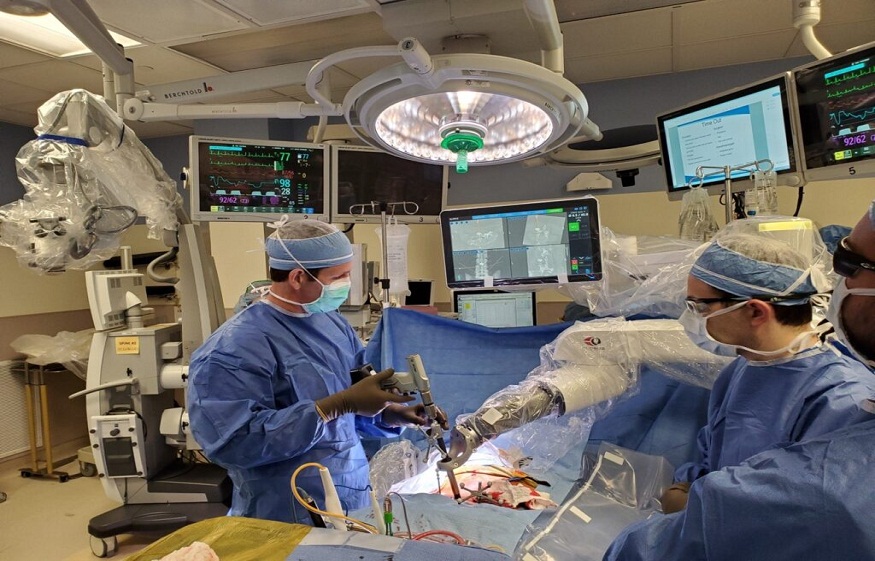
Artificial intelligence (AI) is reshaping the field of spinal surgery, offering surgeons innovative tools for approaching complex procedures, particularly in the design of customized spinal implants. Dr. Larry Davidson, a leader in AI-driven medical advancements, recognizes that AI tools are enabling the creation of implants specifically tailored to each patient’s unique spinal anatomy. By combining advanced data analysis and precision engineering, AI allows for personalized solutions that can improve the effectiveness of spinal surgeries, shorten recovery times and minimize complications.
The Importance of Customization in Spinal Implants
Every patient’s spine is unique, making a one-size-fits-all approach to spinal implants less effective in many cases. Traditional implants, while designed to address common spinal issues, may not align perfectly with the intricate anatomy of an individual’s spine. This can lead to complications, such as implant misalignment, instability and longer recovery times. By customizing implants to match the patient’s specific spinal curvature, vertebral size and bone density, surgeons can optimize the chances of a successful spinal fusion and improve long-term outcomes.
AI’s ability to analyze patient-specific data—including imaging scans and 3D models—enables surgeons to design implants that precisely fit an individual’s anatomy. This personalized approach is particularly valuable in complex cases where standard implants may not provide sufficient support or stability. For instance, in patients with scoliosis or congenital deformities, standard implants might not address the unique alignment needs, increasing the risk of complications. With AI-driven customization, surgeons can ensure that each implant matches the patient’s anatomy, reducing the likelihood of postoperative issues and enhancing overall stability.
AI-Driven Design of Implants
The process of customizing spinal implants with AI begins with comprehensive data collection and analysis. By leveraging machine learning algorithms, AI systems analyze imaging data—such as MRIs and CT scans—to create highly accurate 3D models of the patient’s spine. These models offer detailed insights into spinal curvature, vertebral dimensions and bone density, which are critical for designing a perfectly fitting implant.
Once the 3D model is constructed, AI-driven software enables surgeons to design implants that match each patient’s spinal anatomy. Surgeons can virtually simulate different surgical scenarios, testing the custom implant in a virtual environment before the actual procedure. This allows them to anticipate how the implant will interact with the patient’s spine during movement, significantly reducing the risk of complications post-surgery. For example, in cases where spinal instability is a concern, AI simulations can test implant stability across various motions, ensuring that the final design provides the necessary support.
Moreover, AI can optimize implant design based on individual characteristics, such as bone quality and strength. In patients with osteoporosis or weakened bone density, AI can recommend structural reinforcements within the implant to provide additional stability. This level of customization ensures that the implant not only fits well but also meets the patient’s specific biomechanical needs, leading to a more successful fusion.
Reducing Surgical Complications with Custom Implants
One of the primary benefits of AI-designed custom implants is the reduction of surgical complications. Poorly fitted implants are often associated with a range of issues, from chronic pain to hardware failure, which may require additional corrective surgeries. With AI, surgeons can tailor the implant’s shape, size and material to the patient’s exact needs, significantly lowering the risk of complications.
AI also assists in selecting the most appropriate materials for implants. For example, in cases where a patient has lower bone density, AI can recommend materials that promote better integration and healing. Titanium or titanium alloy, commonly used in orthopedic implants, may be combined with porous materials to encourage bone growth, creating a stronger bond between the implant and the vertebrae. Additionally, AI can assess the patient’s lifestyle and activity level, suggesting materials that provide durability while supporting daily movement, ensuring that the implant can withstand the patient’s unique demands.
In patients who are particularly active or have high physical demands, AI can analyze data to recommend flexible materials or designs that allow for a greater range of motion while still providing adequate stability. This adaptability reduces the likelihood of hardware-related complications and supports a smoother, more comfortable recovery experience.
Enhancing Surgical Precision and Efficiency
Custom implants designed with the help of AI contribute to greater precision and efficiency during surgery. Since the implants are tailored to fit the patient’s unique spinal structure, the surgical procedure itself becomes more streamlined. Surgeons spend less time adjusting or modifying standard implants during the operation, which reduces the overall operating time and lowers the risk of complications associated with prolonged surgery.
Additionally, AI-designed implants support minimally invasive techniques, allowing surgeons to make smaller incisions and limit the manipulation of surrounding tissues. For many patients, this translates to quicker recovery times, less postoperative pain and reduced scarring. In complex cases where significant spinal correction is needed, AI enables surgeons to achieve more accurate alignment with minimal disruption, leading to better outcomes and shorter hospital stays.
For example, in cases involving patients with scoliosis, AI can tailor the curvature and angle of the implant to the specific spinal deformity, enabling surgeons to achieve precise alignment with minimal adjustment. This eliminates the need for excessive manipulation during surgery, reducing the time the patient spends under anesthesia and decreasing the chances of infection or other complications associated with longer surgeries.
Facilitating Postoperative Monitoring and Adjustments
AI’s benefits extend beyond the operating room, as custom implants designed with AI also aid in postoperative monitoring and adjustment. By analyzing post-surgical imaging, AI can assess how well the implant is integrating with the patient’s bone structure, tracking factors like bone growth around the implant and identifying any shifts in alignment.
In cases where minor adjustments may be necessary, AI can recommend specific changes to physical therapy regimens to promote optimal healing and alignment. For instance, if the implant shows signs of slight misalignment, AI might suggest exercises to strengthen the muscles around the spine, providing additional support and potentially correcting the alignment without further intervention. This level of postoperative insight helps ensure that the implant continues to function effectively, reducing the need for future surgeries and supporting long-term patient health.
The Future of AI in Spinal Implant Customization
As AI technology continues to advance, the future of AI-driven customization in spinal implants promises even greater precision and personalization. With developments in robotics, 3D printing and advanced imaging, AI will soon be able to integrate real-time surgical adjustments and fully personalized implant manufacturing. Surgeons could use AI-driven robotic systems that adapt in real-time during surgery, creating implants that accommodate any unforeseen changes in spinal anatomy.
Furthermore, advancements in biocompatible materials may enable the production of implants that promote natural bone regeneration, creating a stronger bond between the implant and surrounding tissue. By incorporating AI, 3D-printed implants could be manufactured to match each patient’s specific biomechanical needs, providing both immediate support and long-term integration.
AI as a Catalyst for Personalized Spinal Surgery
AI is transforming the way spinal implants are designed, offering personalized solutions that improve the fitness, functionality and long-term success of spinal fusion surgeries. By analyzing patient-specific data and creating custom implants tailored to everyone’s spinal anatomy, AI minimizes surgical complications, enhances precision and promotes faster recovery. Surgeons like Dr. Larry Davidson highlight that the future of spinal surgery very likely lies in AI-driven customization.






Leave a Reply
You must be logged in to post a comment.